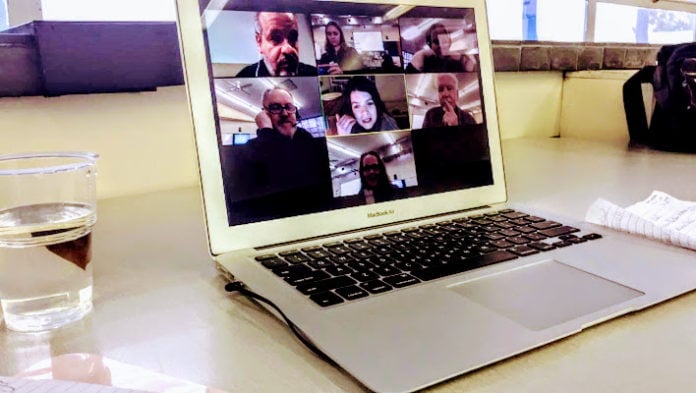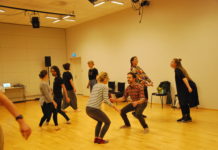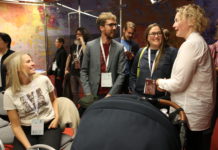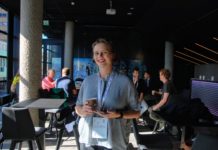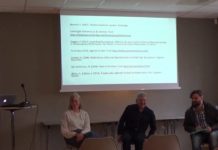Delegates at the 9th International Drama in Education Research Institute were treated to an abundance of exciting and engaging practical workshops during the 7-day event. To give you a flavour of what was on offer, the Dialogue team have put together a series of toolkits that include the workshop abstracts, biographies of the workshop leaders, and featured activities. It’s important to note that these activities are by no means comprehensive of the overall workshops but merely represent a small portion of the activities being introduced to participants.
Hearing Children’s Voices
Facilitated by Peter O’Connor, Briar O’Connor, and Caitlin Kennedy (New Zealand)

“This workshop questions how applied theatre as research might place children’s voices at the forefront of government policy. So much is done for and to children: where are the opportunities for children to be heard speaking about important aspects of their lives? We reflect on 14 years of an applied theatre project, Everyday Theatre, designed to provide a forum for children to understand and respond to family violence and child abuse. We present a case study of adapting this project to work with vulnerable children to inform policy on placing children in care. The workshop provides participants with an experience of how children created the script, for sharing with Oranga Tamariki, the Ministry for Children.”
Professor Peter O’Connor is Head of the School of Critical Studies in Education and Social Work at the University of Auckland and Director of the Critical Research Unit in Applied Theatre. His theatre making and research focuses on working with vulnerable communities.
Briar O’Connor is Managing Director of Applied Theatre Consultants Ltd and a PhD candidate in the School of Social Work and Counselling at The University of Auckland.
Caitlin Kennedy is a Research Assistant at the School of Critical Studies in Education and Social Work at the University of Auckland, and is also a Games Master with Everyday Theatre. She has a Master’s degree in Applied Theatre from Goldsmiths College, London.
Featured Activity:
These activities are geared towards children over the age of 11 who have had experience in the care system.
 The Facilitators introduce a fictitious story of ‘T’, a twelve-year-old child who lives with an abusive father and neglectful mother
The Facilitators introduce a fictitious story of ‘T’, a twelve-year-old child who lives with an abusive father and neglectful mother- The Facilitators move between acting out various different scenes to contextualise the contentious relationship between T and his neglectful and abusive parents
- The Facilitators break from role to engage the participants in creating the next phase of T’s story
- Devising the rest of his story is carried out in multiple ways, the first a sculpted tableau that shows how the participants believe T would look as he is waiting for a social worker to talk to him following his father’s arrest
- Participants are paired up, one being the designated as ‘clay’ and the other as ‘sculptor’ to mould this tableau
 With the ‘clay’ participants remaining frozen, the tableaus are then shared with all of the ‘sculptors’, giving them an opportunity to comment on the different characterisations of T
With the ‘clay’ participants remaining frozen, the tableaus are then shared with all of the ‘sculptors’, giving them an opportunity to comment on the different characterisations of T- The ‘sculptor’ participants then approach their ‘clay’ partners and freeze in a still image that reflects how they feel they would respond as the social worker approaching T
- The ‘clay’ participants remove themselves from the tableau, looking at all of the characterisations of social workers around the room, commenting on what they see
- They return to their pairs as T and the social worker, and improvise a scene based on one another’s reactions/responses
- The Facilitators ask these pairs to end this particular scene and transition into a new scene wherein T has a phone conversation with his friend ‘Jack’ after T has been in care for a week
- Each pair takes turns playing T and Jack, switching halfway through to shift the dialogue
- These exercises are just some examples of the activities used to engage participants in T’s story and to gain valuable knowledge from the participants themselves on their experiences within care
How to Catch a Flying Pig: An Experience of Embodiment Work in an Online Room
Facilitated by Petro Janse van Vuuren (South Africa) and Christian F. Freisleben-Teutscher (Austria)
“This workshop is a practical experience that builds on the presentation by the same title. Is the idea of doing embodiment work online without losing impact a flying pig? Here presenters will demonstrate principles of design and organisation using embodiment in settings enabled by technology. We will present different improvisation methods that can be used in online settings highlighting its effects on community building, collaboration and interaction on one hand and on personal development on the other. The aim is to guide practitioners and facilitators who are interested in engaging similarly. The work is based on the adaptations and inventions two academics had made over the past two years to engage PhD students and other participants, who are scattered across the African continent and the world, in embodied processes. The process will be facilitated online from Austria (Christian) and South Africa (Petro).”
Dr. Petro Janse van Vuuren is an Applied Performance learning strategist and researcher. She is a lecturer and PhD co-ordinator at Drama for Life, Wits University and she runs a consulting business in organisational development, Playing Mantis. Here she trains organisation development practitioners and business coaches in applied performance methodologies. Petro has published a number of articles and book chapters on her work and has presented at various conferences on applied performance and organisation development.
Christian F. Freisleben-Teutscher studied communication science and dramatics at the University of Vienna. He is working as facilitator and teacher in the fields of adult education, health care and social work. He is also working part time at the St. Pölten University of Applied Sciences (didactics of higher education). Applied improvisation is his most important tool kit in offline and online facilitation, training, teaching and research. He is working on a thesis on applied improvisation.
Featured Activity:
- Participants are asked to download and join a Zoom session prior to the start of the workshop, so that they enter into an online chat room with all of the workshop Participants and Facilitators
- Through the use of Strategic Narrative Embodiment, the Facilitators ask the group to think of their ‘flying pig’
- …that is to say, when participants’ are posed the question “When will you manage to achieve X?”, their response would be “When pigs fly…”
 Participants are then instructed to step away from their camera, finding a space in the room to practice embodying their ‘flying pig’ (through the use of voice, body, movement, etc.)
Participants are then instructed to step away from their camera, finding a space in the room to practice embodying their ‘flying pig’ (through the use of voice, body, movement, etc.)- When all participants have returned to the collective online space, the Facilitators have them all share their embodiments on the screen simultaneously (relieving the pressure of performing individually)
- The Facilitators follow up the exercise with a debrief, asking Participants to describe what they noticed about each other’s ‘flying pig’
- To follow, the Facilitators probe the Participants to think about how they would react on impulse if they were to meet their ‘flying pig’
- Again, the participants are instructed to step away from the camera and into their own space to practice the physicality of this response
- When returning to the online room, participants are paired up and instructed to teach one another the characterisation of their ‘flying pigs’
- Once each pair feels confident embodying the other’s pig, the Facilitators request that each pair practice responding to their own ‘flying pig’ being performed by their partners
- Participants are encouraged to respond in different ways to see if and how their ‘flying pig’ will react differently
- Once both partners have practiced this within the online chatroom, the group is asked to freeze in a still image that they feel represents a poignant moment within their pairing exercise
- To conclude, each participant is tasked with describing the picture created by these still images collectively via a short rhyme


